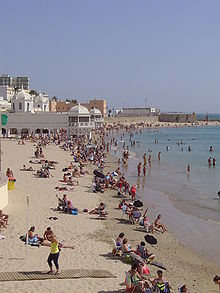- Costa de la Luz
-
 La Caleta beach, Cádiz
La Caleta beach, Cádiz
The Costa de la Luz (Spanish pronunciation: [ˈkosta ðe la luθ], "Coast of Light") is a section of the Andalusian coast in Spain facing the Atlantic; it extends from Tarifa in the south, along the coasts of the Province of Cádiz and the Province of Huelva, to the mouth of the Guadiana River.
A popular destination for vacationing Spaniards, in recent years the Costa de la Luz has become more popular with foreign visitors, especially the French and the Germans. Increasing urbanization and tourism-oriented development of parts of the coast have had economic benefits, but these trends have also ignited fevered real-estate speculations and some environmental degradation.
Contents
Attractions and recreation
Aside from the beaches and the sunshine, there are ample opportunities and facilities for leisure activities, like fine dining, golf, kitesurfing, boating, and other water sports. The Costa de la Luz is especially noted for the beauty of its protected natural reserves and a number of first-rate natural attractions. Among them are: the Doñana National Park, where endangered species, such as the Spanish Imperial Eagle, also known as Adalbert's Eagle (Aquila adalberti), and the Iberian Lynx (Felis pardina), can occasionally be sighted; the picturesque Bay of Cádiz; the steeply-pitched shorelines of the southern section of the Andalusian coastline; the salt marshes of Barbate and the seaside cliffs at La Breña (both within the La Breña y Marismas del Barbate Natural Park); and the sprawling wetlands at the mouths of the rivers Tinto and Odiel, where there is a profusion of water fowl and, in season, other migratory birds, including storks and flamingos.
Among the towns, cities, and beaches of most interest to a visitor to the Costa de la Luz (in order, from northwest to southeast) are: Ayamonte, Isla Cristina, Lepe, El Portil, Punta Umbría, Matalascañas, Sanlúcar de Barrameda, Chipiona, El Puerto de Santa María, Cádiz, Chiclana de la Frontera, Conil de la Frontera, Zahara de los Atunes, Los Caños de Meca, Vejer de la Frontera, Bolonia, and Tarifa.
Other places along the coast, of somewhat less touristic interest (again, in order, from northwest to southeast), are: Isla Canela, Islantilla, La Antilla, El Terrón, Cartaya, El Rompido, Mazagón, Rota, Puerto Réal, San Fernando, and Sancti Petri.
A further facility of nterest is the atmospheric research station El Arenosillo, where sometimes rockets are launched.
History
The Costa de la Luz has a rich history that dates back to the twelfth century BCE. Cultural attractions include Baelo Claudia, the well-preserved ruins of a small Roman city; Cape Trafalgar, where, in 1805, in sight of this promontory, the English admiral, Horatio Nelson, defeated a combined French and Spanish fleet; and La Rábida Monastery.
At the Rábida Monastery in Palos de la Frontera near Huelva, Christopher Columbus sought the aid of the Franciscan brothers, hoping to enlist them as advocates for his scheme to launch a voyage of discovery. They introduced Columbus to a wealthy local seafaring family, the Pinzón brothers, who eventually prevailed upon Ferdinand and Isabella to listen to Columbus's pitch for support. With royal patronage and the collaboration of the Pinzóns, Columbus was able to secure his three ships as well as local crews from the Huelva area. In fact, there is a persistent belief that Columbus settled on his final westward route after speaking to a local sailor named Alonso Sánchez.
Note
This article is loosely based on a translation of the corresponding article in the Spanish Wikipedia.
External links
Coordinates: 36°15′N 5°58′W / 36.25°N 5.967°W
- Official web Costa de la Luz Huelva (Spanish)
- Official web Costa de la Luz Cadiz (Spanish)
- Costa de la Luz Travel Guide
List of the Spanish Costas Costa de Almería · Costa del Azahar · Costa Blanca · Costa Brava · Costa Cálida
Costa Daurada · Costa Tropical · Costa de la Luz · Costa do Marisco · Costa da Morte · Costa del Sol · Costa VerdeCategories:- Cádiz Province
- Coasts of Spain
- Costa de la Luz
- Huelva Province
- Tourism in Spain
Wikimedia Foundation. 2010.


